A few weeks ago I wrote about the SkyLink at DFW airport, and the attributes that made it an almost ideal transit system (high frequency, grade-separated right of way, central control reducing operator costs, etc.).
Visiting Vancouver, it was interesting to see how many of these attributes SkyTrain possesses. Three minute headways during peak commute hours was pretty impressive.
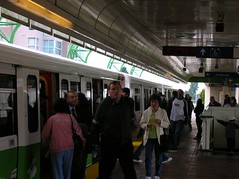
|
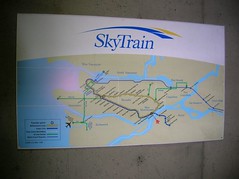
|
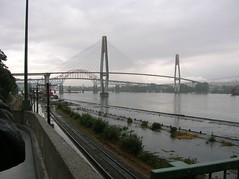
|
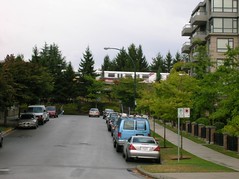
|
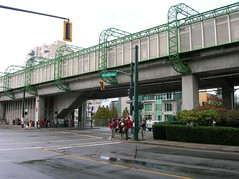
|
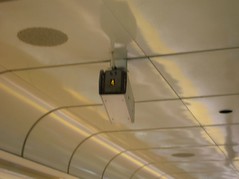
|
A few weeks ago I wrote about the SkyLink at DFW airport, and the attributes that made it an almost ideal transit system (high frequency, grade-separated right of way, central control reducing operator costs, etc.).
Visiting Vancouver, it was interesting to see how many of these attributes SkyTrain possesses. Three minute headways during peak commute hours was pretty impressive.
But, in reality it’s not obviously superior to MAX. The infrastructure has a HUGE visual impact on the areas it travels through. And it’s only considered medium-capacity transit. The vehicle capacity is significantly lower than MAX, although the frequency offsets this.
It’s also more expensive. They are actually planning a Light Rail spur line to feed SkyTrain from one of the suburbs because it will cost 1/4 or 1/3 of what SkyTrain would.
Still, it’s an impressive system. I was particularly struck with the attention to security. There are cameras everywhere and each window has a panic button strip that is supposed to summon help within 3 minutes. That would be a nice addition to MAX.
And that river crossing would be a great model for the proposed Caruthers Crossing Light Rail bridge.
12 responses to “SkyTrain”
It’s worth pointing out that SkyTrain and MAX both opened in 1986. (ST was built as a part of Expo ’86). And it’s been interesting how each has system has expanded and prompted development over the past 20 years.
Trackswise, I’d say Tri-Met is a bit ahead of the game. Westside MAX opened a few years before ST expanded. ST to and from Vancouver’s airport won’t open until 2011. A commuter rail line serves Vanocouver’s east burbs, though.
I visit Vancouver at least twice a year. I always enjoy being able to park the car stories underground and get around the entire metropolitan region on foot or using public tranport. Where else can you use public transport to take a short ferry ride from downtown to a bus that will drop you off in the parking lot of ski resort? I think their bus system is better than ours ‘cept for there’s no central transit mall and the schedules and maps can be a bit confusing.
[Chris, I have a somewhat-related question you might be able to answer: Do you know why buses on major lines in the Seattle and Vancouver-areas are powered by overhead electrical lines but Tri-Met never did it? Cheap, plentiful hydro-power was just as available here.]
Chris –
There is a transit technology which covers your criteria for an ideal transit system…
* high frequency
* grade-separated right of way
* central control reducing operator costs
Additionally, unlike SkyTrain or other conventional elevated rail systems, this technology offers these additional benefits:
* narrow, less obtrusive guideway structures and stations
* quieter running in most circumstances than steel rail
* may be integrated directly into buildings
This technology (if you haven’t already guessed) is Monorail. Unfortunately, in the US, there are few examples of monorails being used as true urban transit systems. They are relegated (perhaps due to typecasting) to theme parks and tourist cities.
Las Vegas’ system comes closest to true public transit, but has a very limited route and decreasing ridership. Seattle tried but got mired in a funding controversy. Other countries however, especially in Asia, have extensive systems.
I don’t think monorail (or any principally elevated system) would fit well in Portland — our streets are too narrow and our blocks are too short for elevated infrastructure, and we already have a well-established system in place.
But for cities starting from scratch, I hope the experiences of Seattle and Las Vegas don’t immediately dissuade them from studying the technology.
– Bob R.
Eric –
Portland at one time had several electric trolley bus routes, just like Seattle, San Francisco and Vancouver, but they were replaced with diesel buses over time. Some have argued that ETB should make a return to Portland as an alternative (or supplement) to streetcar expansion.
– Bob R.
The Canada Line (service to the airport and the southern suburb of Richmond) will actually open in the end of 2009, in time for the Olympics. The Evergreen Line light rail to Coquitlam (outer eastern suburbs) was scheduled to open in 2009 but may be delayed.
One of the big reasons for the focus on security is that the trains have no drivers.
SkyTrain’s ridership statistics are impressive: over 220,000 daily boardings on the two lines. Of course, construction costs are much higher.
Well, there’s possibly one other big difference between SkyTrain and the MAX. According to a number of sources I’ve found, Skytrain is profitable — its farebox revenue are 104% of its operating expenses.
However, none of the sources that I’ve found are authoritative, and I’ve been completely unable to find ANY definitive revenue & budget statistics from Translink. So SkyTrain’s purported self-sufficiency might be an urban legend. Anyone know where some definitive numbers might be found?
Tokyo has a couple of monorail systems, but they are typically short – just a half mile or so – and serve extremely heavy-traffic corridors (ie, connecting massive train stations together). But they don’t have ‘extensive monorail systems.’
Monorails are way up in the air, are ugly, require escape routes along the tracks, earthquake-proof supports, run on rubber tires (so much for energy savings that steel wheel-on-tracks provide!), and are cramped. Switching technology is also extremely expensive; there are only maybe 2 manufacturers in the world, and maintenance is also very expensive.
Rail is cheaper, is standardized, and there are a multitude of companies that make parts, tracks, and trains.
Actually, any proprietary system – whether it is a computer, software program, or whatever – is always more expensive than one based upon standards.
Oh, and you can also elevate rails in the air just like a monorail. Much of the Seattle Link Light rail system to Tukwila will be elevated.
For over 100 years, the NYC Subway system has had elevated sections: http://images.nycsubway.org/i6000/img_6416.jpg
Tokyo has a couple of monorail systems, but they are typically short – just a half mile or so – and serve extremely heavy-traffic corridors (ie, connecting massive train stations together). But they don’t have ‘extensive monorail systems.’
Japan:
Osaka, 23.8km, 16 stations, 77,900/day
Tama, 16.0km, 19 stations, 92,700/day
Naha, 12.8km, 15 stations, 35,000/day
Tokyo-Haneda, 17.8km, 10 stations, 137,900/day
Kitakyushu, 8.8km, 13 stations, 31,700/day
Chiba City, 15.5 km, 18 stations, 40,000/day
Asia:
Kuala Lumpur, Malaysia, 8.6km, 11 stations, 45,000/day
Chongqing, China, 13.5km, 14 stations (recently opened)
Other Countries:
Moscow Monorail, 4.7km, 6 stations: http://www.monorails.org/tMspages/Moscow01.html (You call this ugly?)
USA:
Las Vegas is the only system in the US comparable to a true public transit system although without an airport or downtown link mainly operates for casino tourists. 6.3 km, 7 stations, 30,000/day (Needs at least 50,000/day to break even.)
Monorails are way up in the air, are ugly, require escape routes along the tracks, earthquake-proof supports, run on rubber tires (so much for energy savings that steel wheel-on-tracks provide!), and are cramped. Switching technology is also extremely expensive; there are only maybe 2 manufacturers in the world, and maintenance is also very expensive.
Monorails are no more “way up in the air” than elevated rail, elevated rail also requires earthquake-proof supports.
“Ugly”? How subjective is that? Compared to elevated rail? How does elevated rails’ much more massive structures make it a less “ugly” solution than monorail?
Rubber tires give you a trade-off: Less energy efficiency but less vibration of nearby structures and much quieter operation, especially on curves.
I don’t know where you get “cramped” from, as this is a function of number of cars per train and ridership. Most monorail cars have bodies at least as wide as the Portland Streetcar. Don’t think of Disney’s packed-like-sardines tourist rides when thinking of urban monorails.
True, there aren’t a lot of monorail manufacturers (just small companies like Bombardier and Hitachi, for example), but there is increasing standardization in the industry (in terms of guideway design and switching platforms, for example)
It is true that less common technologies cost more than standardized technologies, but the point of Chris’s original post was that his ideal transit system would be completely grade separated. You only get that buy going above or below ground. For long stretches of above-ground or exclusively above-ground, the cost savings from the smaller guideway and smaller supports required for monorail eventually outweigh the more expensive proprietary system components.
Oh, and you can also elevate rails in the air just like a monorail.
Yes, and then your costs go way up compared to monorail, and your structures are much larger, and you still need escape routes, etc. Look at how massive the Interstate MAX viaduct is north of Denver Ave. Would you really want that running down the main streets of a downtown area?
As I mentioned in my original post, I don’t think monorails would fit in well with Portland. But for other cities, they offer many of the advantages of subway in terms of grade separation, few of the disadvantages of elevated rail, and keep passengers in the daylight rather than down in tunnels.
Rail works best where a mix of elevations are required. It would be hugely expensive (but not impossible) to run monorail in a subway, and pretty darn near impossible to run monorail at street level. But if your requirements are for an inherently elevated system, all I am saying is that planners should seriously consider monorail when deciding what mode to use.
– Bob R.
Wow! Guess I was behind the times there! I had seen some really old, nasty pics of clunky monorails running 1-2 km routes in Japan, figured thats all there was.
I must admit, however, that I think elevated fixed-guideway structures are sinfully ugly. On that note, one reason the Seattle monorail was killed was because they were going to have to level around 10 buildings, the construction costs skyrocketed (making our aerial tram fiasco look puny in comparison), and the supports were massive when engineered; the concept sketches were a complete joke – and the entire line needed emergency walkways along the entire length of the track, so it was hardly a slender little thing held up in the air like the existing monorail is. It would have been as massive as an elevated rail line. But then the US has far more stringent safety guidelines than any other country.
Justin –
I attempted to post a reply here yesterday but apparently it did not complete properly…
Just wanted to say thanks for keeping an open mind on this topic.
A note on Seattle, the cost increases were not in Tram territory… the real problem was that the funding package could not cover the costs in any reasonable time and the interest on bonds would have driven total final costs from around $3bn to $11bn – a financing disaster. Rather than shorten the line, open the line to rebidding, phase the line, and rather than proposing an increase in taxes so that the line could have been paid off sooner (a “tax increase” that would have actually cost taxpayers billions less), the board sent the project pretty much as-is back to voters, who were probably right to shut down the operation.
– Bob R.
SkyTrain has an emergency walkway in the centre of the elevated guideway between the two sets of rails. The headway of the trains along the combined Expo Line section of the network are as little of 45 seconds in rush-hour. The system is nowhere near reaching its theoretical capacity. The network was engineered to eventually move 50,000 people per direction per hour, and today moves in the neighbourhood of 24,000. I too have heard that SkyTrain is revenue positive, but I believe that only applies to the original Expo line that was built for Expo86 in 1986 and has paid off its construction costs. The Millennium line that opened in 2001 and construction costs will be amortized for another decade or so. I think most major infrastructure projects in the region are designed on a 20 year amortization schedule. The new Canada Line is a P3 (public Private Partnership) and a large portion of the construction cost (630 million of the 2.1 billion) are being born by a private sector consortium in exchange for a limited 30 year operating concession.
I chuckled a bit hearing Bombardier called a little company. It is the largest manufacturer of passenger rail and urban transit vehicles in the world and the third largest manufacturer of commercial aircraft in the world after Boeing and Airbus. Bombardier supplied the cars and linear induction motors for the original two SkyTrain Lines but the new Canada Line uses conventional metro technology and rolling stock manufactured by Rotem of Korea.
SFUVancouver –
It took me a minute to find the reference to Bombardier as a “small” company — I made it last September. :-) The reference was meant in jest… Here in Portland, our original light rail cars (still going strong after 20 years) were manufactured by Bombardier as well.
You mention that one of the new SkyTrain lines will not be Linear Induction Motor based, but conventional metro… do you know why this is? Is it a cost consideration, performance, some other reason? It would seem to make some sense to stick with what they’ve developed so far unless there is a compelling reason to switch.
– Bob R.
Great blog!
I have been riding the Vancouver SkyTrain since I was a a little kid.
Yes, it seems to be common knowledge that the Expo line runs at an operating profit. The Millennium Line certainly doesn’t though. Check http://www.translink.bc.ca – there must be official reports there.
In other news, the government here just announced the conversion of all rapid transit lines in planning to ALRT technology (SkyTrain) – no more LRT.
The decision was made due to ridership targets the government has as part of its environmental campaign. LRT would cost just as much as SkyTrain if it was designed to match the service levels and thus ridership.
So, the Evergreen Line to the Northeast (2014) will roll onto the existing system at Lougheed, and the Millennium SkyTrain line will be extended (mostly subway) from VCC all the way to the UBC by 2020.
Check the wiki here for details: http://en.wikipedia.org/wiki/SkyTrain_%28Vancouver%29
The Canada Line from downtown to Richmond and the Airport will be in service next year. As mentioned, that line was a public-private-partnership. The government reviewed three bids – one of which withdrew. The remaining two included the winning proponent, and the losing consortium led by Bombardier. This was unfortunate in my mind because it would have been nice to have a fully integrated system.
Sorry to go on and on!
Anyway, I can’t wait to come down to Portland and check out Max. I have heard a lot about it!